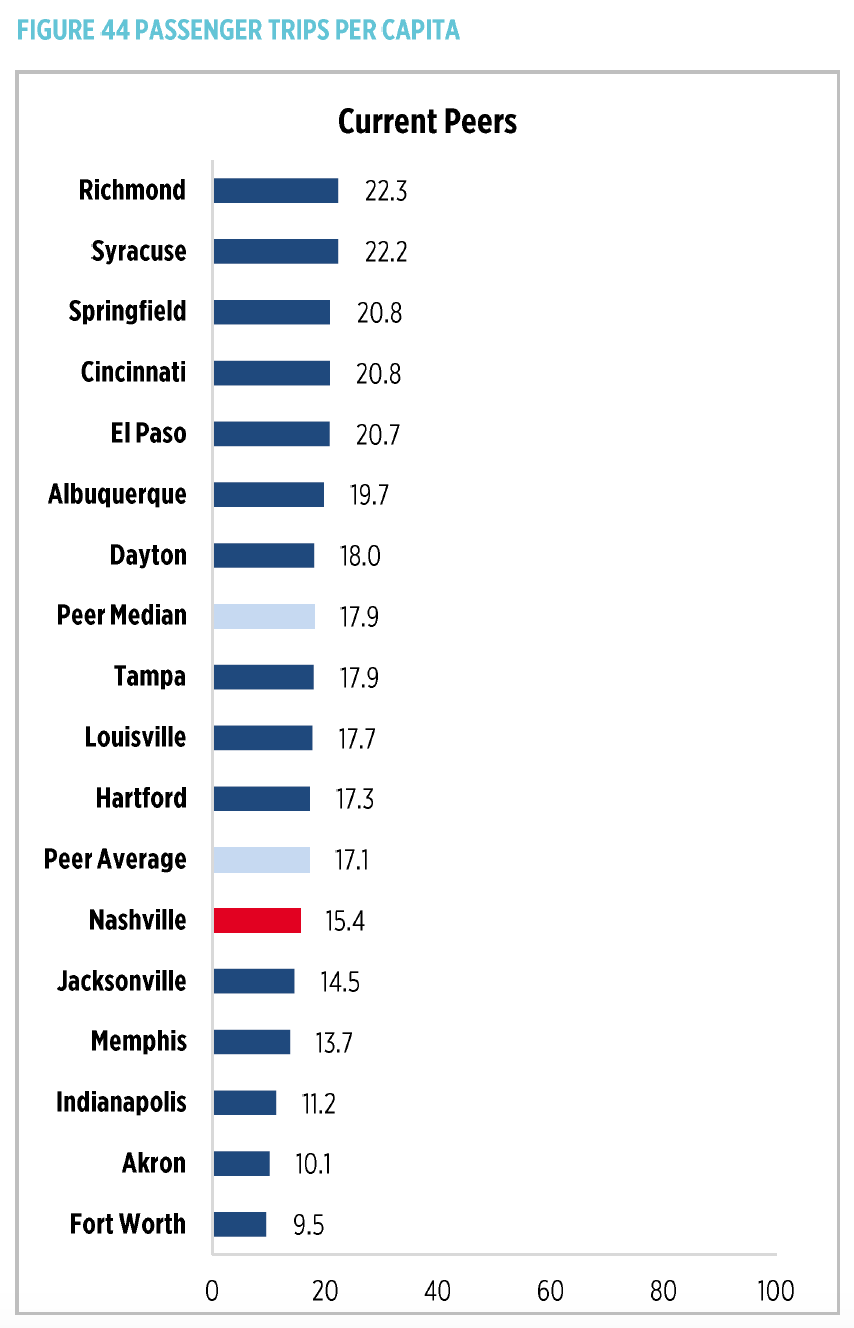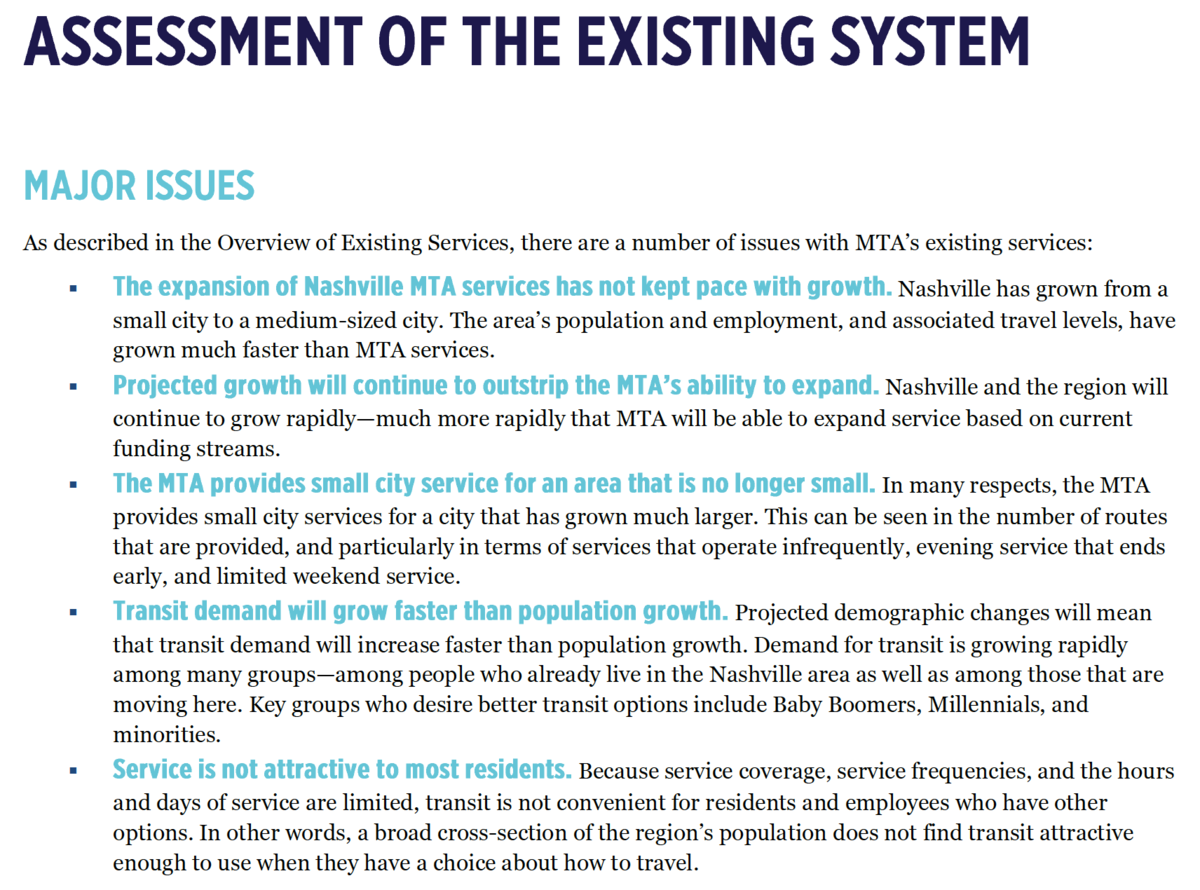Nashville Public Radio
Tony Gonzalez
The most in-depth study of Nashville’s transit system in recent years has arrived, and it paints a detailed picture of why the city is struggling to get a growing population where they want to go.
The existing MTA bus system provides “small city service for a city that isn’t small anymore,” the study found.
Most of the 151-page report focuses on city buses, which rider Terrance Williamson knows well. On a recent morning, he got to his stop on time to catch a ride to his distribution job downtown, only to be surprised.
“I would like to see more consistent times,” he said. “The bus was supposed to come at 10:26 and it came earlier than that.”
So he missed it — the kind of moment that would cause some people to give up on the system. But Williamson just wants it to work better.
“I think sometimes in this city — we just think immediate. We don’t think 20 to 25 years down the road,” he said.
That’s where the new nMotion 2015 “State of the System” report comes in, says Steve Bland, CEO for the MTA.
“Would it have been great if something grandiose or really effective were started 10 years ago? Sure. But it’s not too late,” he told Nashville Public Radio. “MTA and the RTA have done a pretty effective job over the last 10 years in their traditional roles, but the nature of the growth and the changes in Nashville mean we really need to change what those roles are.”
The MTA collected thousands of complaints and ideas from riders and also compared Nashville’s bus system to 21 other cities.
Researchers found that buses here don’t come frequently enough. Ridership is low in a city that is especially sprawling — a big challenge for any transit agency.
Ranked against other cities
The study pitted Nashville against 15 “peer” cities and six especially high-performing “aspirational peers,” where significant investments have clearly placed them ahead of Nashville.
Total ridership: Relatively low (9.3 million riders in Nashville in 2012).
Productivity: Nashville performs above average by carrying 25.7 passengers per vehicle service hour.
Cost: Nashville MTA’s operating cost per bus service hour of $105 is slightly below the average costs of its current peers. Cost to the city per passenger was better than the peer average.
Unique: Nashville was found to have much more expansive transit for the disabled.
Convenience desired
The good news is that Nashville’s system is pretty cost-efficient. While the study says it will take “substantially more ”funding to get better, Bland says the first step is knowing what people care about — a step that may have been missed with the failed Amp bus project.
“So if we design something that doesn’t meet a customer’s definition of convenience, they flat out aren’t going to use it,” Bland said.
Convenience — for McQueen Michel, of East Nashville — would be later hours, including on weekends. He’s a musician who often pulls late shifts at a restaurant downtown.
“There’s a lot of people that work that don’t work the normal 9 to 5 and it seems like the bus system is kind of geared that way,” Michel said. “You can have more busses but if nobody’s taking it, that’s a waste of money. But I think if you can have extended hours, at least, people would be taking it — you’d be amazed how many people would take it over night.”
That’s the big goal: getting more transit riders so that traffic doesn’t get worse.
Researchers found that Nashvillians consider service frequent when a bus arrives about every 10 minutes, while MTA has typically defined “frequent” as every 30 minutes. Only nine of the city’s 46 routes provide service every 15 minutes, and only during peak times.
Based on population and jobs density, only a few pockets of the city can create enough demand for high-capacity transit — defined as service every 5 to 10 minutes — and that’s not expected to change quickly.
Of note, a huge portion of millennials in the city (73 percent) said they want to live in an area where a majority of trips are not by car. But only 6 percent said they feel they live in such a neighborhood now.
“There’s certain things that I’m willing to accept,” Michel said. “I’m willing to walk two, three blocks to my bus stop if my bus takes me close to work, ‘cause I’m used to walking.”
Michel — and the city — just want to find the easiest way to get around.
MTA by the numbers
Ridership:
Approximately 33,000 passengers per weekday, 16,000 on Saturdays, and 10,000 on Sundays.
Busy routes:
Route 55 Murfreesboro Pike BRT and Route 56 Gallatin Road BRT have the highest weekday ridership, followed by the routes on Nolensville Pike, Charlotte Pike, Dickerson Road, Bordeaux and Hillsboro.
Intensity:
Busy bus routes carry about 60 riders per hour, but some carry just 10 per hour.
Proximity:
About 49 percent of Davidson County residents live within a quarter-mile of an MTA bus stop (that’s the distance that experts say most riders are willing to walk to a bus).



I ride the bus quite often and I have been disturbed in recent weeks by the fact that MTA buses have often been taking unannounced, and therefore unexpected, detours. In some cases, this has led to my not being picked up at all. At other times, it has taken me in unexpected directions that did not put me close to my intended destination and wound up with my having to do some unexpected walking, sometimes for a noticeable distance. In one case that happened only two days ago, such a detour would have wound up making me late for the first day of a new job, if I hadn’t decided to take a bus that would get me there extra early, so that I could make sure that I found the place in plenty of time. If I had taken the bus recommended by your website, that left an hour later, I would have been quite late for work.
I will be honest; I’m not quite sure of how you could deal with such a situation as this. On the other hand, I am aware that if customers are left at bus stops without being picked up, or taken to places other than they expected to be taken to, public confidence in your services and the use of them are both going to drop, something that I believe you’re trying to avoid. And, as the number of detours faced by Nashville buses seems to be rising, as I’ve run into at least 5 in the last four or five days, this would seem to be a matter that I would think that you would want to pay some attention to. Thank you for your attention.
Sincerely,
Maurice W. Lewis Jr.